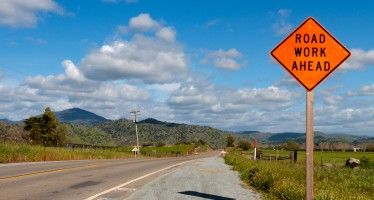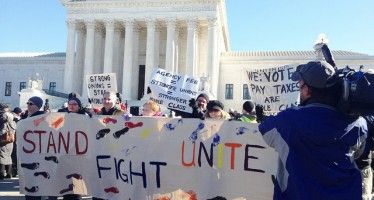Pension Funds' Odd Incentives
OCT. 12, 2010
By DAVE ROBERTS
Billionaire investor Warren Buffett has compared investing in the stock market to gambling in a casino. He criticizes the large volume of daily trading and minute-to-minute tracking of the ups and downs of various stocks by investors in the never-ending search for higher returns rather than focusing on the long-term soundness of companies and parking their money there for the long haul. Unfortunately, Buffett doesn’t sit on the boards of California’s two largest pension funds, which nearly lost their shirts when the stock market tanked in the Great Recession, leaving taxpayers to pick up the bill.
The California Public Employees Retirement System (CalPERS), which had more than half of its investment portfolio in the stock market, lost 36 percent during the financial crisis. Before the crisis the CalPERS fund contained $260 billion; after the crisis there was just $167 billion left. With the market rebound it’s back up to $240 billion, but that’s still nearly 8 percent below the peak of several years ago. The California State Teachers’ Retirement System has fared likewise, losing 33 percent from its $164 billion fund at the height of the market and ending up at $110 billion. It has since rebounded to $139 billion, but that’s still 15 percent off its high.
A big part of the problem is that the people in charge of investing the pension funds are rewarded for risky investments with the potential to get significant returns, thereby earning a commission above their base salaries, but they aren’t punished when those risky investments take a dive. To use Buffett’s analogy, it’s like sending a professional gambler into a Vegas casino with your retirement savings and telling him he’ll get a cut of everything he wins but not to worry if he loses. He might do well for a while, but don’t be surprised if he eventually rolls snake eyes and your nest egg shrinks to a pea.
“Some commentators have said that one of the main reasons for the financial crisis was the perverse incentives that existed in financial institutions in terms of the risk taking they were allowed to do,” said Farouki Majeed, CalPERS senior investment officer, speaking at the International Corporate Governance Network Conference in San Francisco Thursday. “People were shooting for returns without much consideration of risk. At CalPERS we need to do more in terms of tying some of our incentives to risk. Where it is right now, there are various types of parameters in policy that hold investment managers within certain limits and constraints. The important part is to tie risks to the incentive equation and not be merely based on returns.”
That practice has been in place for years with some private investment firms. At TIAA-CREF, which manages $410 billion in investments for a variety of academic and medical institutions, they are just as focused on the risk of their investments as they are on the returns, according to Executive Vice President Scott Evans. “We spend our time discussing what their stomach is telling them whether this risk is in the right place,” he said. “If one of these things blows and we have not properly identified it, the senior management team will be embarrassed and probably unemployed. That helps focus the mind.”
It’s only recently, in the wake of the financial meltdown, that there’s been a similar focus at CalPERS, which has about 100 investment professionals on its payroll. “Risk management at CalPERS has been an evolving thing,” said Majeed. Before the financial crisis, “It was not an item on the board’s agenda in terms of risk. Risk was understood to be managed with a diversified asset allocation program. They were not designed for extreme events. Conventional models are designed for a normal economic environment – stable risk-return relationships. When they break down and are unstable, the kind of decisions you make are wrong.
“Shortly after I arrived in 2007 I tried to get the risk item to be on the board’s agenda. We did that just before the crisis came along, began to talk about the subject. Since then the board has created an ad hoc committee to address risk management on an enterprise-wide basis. That has received the board’s attention. We will have a risk officer with whom we will be working.”
The way California’s pension funds have gambled with their money has been in marked contrast with countries such as Brazil. “In Brazil the pension fund industry is a very regulated and also comfortable environment,” said Marco Geovanne Tobias Da Silva, executive director of PREVI, which manages $80 billion in retirement benefits for 180,000 employees and retirees. “We have a country that bears the highest interest rates ever in real terms. As long as you are focused on government bonds you will easily have double-digit returns. The culture of risk is not as developed in Brazil as abroad. We have had a surplus for the past 80 years. Our major challenge now is to discuss what to do with this surplus.”
Majeed responded, “You can ship some over to us,” as many of the several hundred corporate investors at the conference laughed.
Although CalPERS has formed a committee and is taking risk more seriously, Majeed said, “The real important thing is that risk management has to become part of the investment culture. It has to be ingrained in the investment management process so every manager is thinking about it. It’s ongoing at CalPERS. The other part of it is that risk becomes a forward-looking exercise as well. Most of what we measure and report is mostly backward looking. The board also needs to consider, even though you might not be able to get tangible hard facts, where are the looming risks out there? When is another 50-year flood type of (financial) event likely to happen? The board needs to ask those questions and get those answers and make sure the risk function happens the way it ought to.”
But Evans is pessimistic that much will change until investment managers are not only rewarded for success but also punished for failure. “There’s probably no more important point for an investment management organization managing other people’s assets than the way they are being compensated looks at both risk and return,” he said. “You will get what you pay for. Every one of our investment professionals is measured on that in the area they oversee. If your (return-to-risk) ratio is twice the guy sitting next to you, your compensation is twice the guy sitting next to you. Good investors have always been good risk mangers. Investment managers have to think about both.”
Buffett, in a taped interview played at the conference, agreed that pension funds need to be careful with their dollars rather than constantly chasing high returns. “If a pension fund has (an investment) turnover of more than 10 percent a year they should re-examine what they are all about,” he said. “They don’t need to do it. But the whole world tells them you’re going to be a hero.”
As a result of those heroes turning into goats, California residents are likely going to be socked with higher taxes and fewer services as local governments and school districts are forced to increase their contributions to CalPERS and CalSTRS to cover the money lost in the stock market crash along with ongoing retirement obligations for government employees. “Contributions have already sort of been increased somewhat,” said Majeed. “The CalPERS board has the authority to increase contributions depending on the funded level and so on.”
CalSTRS does not have that authority to increase the contributions from teachers and school districts, which currently pay about 8 percent each, but it will be asking the state Legislature to do so in the next year or two, according to Anne Sheehan, CalSTRS director of corporate governance. “We are doing a good job trying to manage the money for the retirement of the 840,000 beneficiaries we have all over the state,” she said. “Everybody has a teacher, has had a teacher or their children do, and we want to make sure they have got a retirement when they finish that hard job that they have done.”
It remains to be seen whether things really will change at CalPERS now that the financial crisis appears to be behind us. James McRitchie, publisher of PERSWatch.net and a follower of CalPERS for 25 years, said that the 13-member board has largely operated under the radar, rarely receiving attention in the press or from its membership of more than 1.6 million employees, retirees and their families. “There is probably a legitimate gripe as far as who represents the public interest on the CalPERS board,” he said. “It’s represented by public officials like the treasurer. But the public needs to be telling the treasurer ‘Do this, do that.’”
No one ran against two board incumbents in a recent election, and only about 30,000 members bothered to vote, he said. In what McRitchie dubbed the “Incumbent Protection Rule,” the board had planned to implement a gag rule prohibiting board members from publicly criticizing one another – until McRitchie complained and the Sacramento Bee wrote about it and editorialized against it. “That put a stop to it right away,” he said. “If the press actually takes an interest then they have an impact.”
Related Articles
Road repair bill would raise transportation taxes, fees
California motorists will each be paying an extra $900 over the next five years for road maintenance if Senate Bill
Kit fox endangers high-speed rail construction
The California High-Speed Rail Authority faces a new obstacle on its railroad track to construction: the endangered San Joaquin
Union funding endangered by pending Supreme Court case
The average K-12 teacher in California pays at least $30,000 in union dues over the course of a 30-year career,




